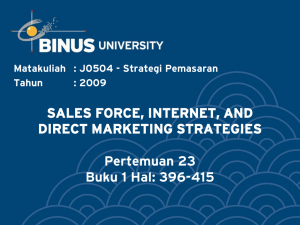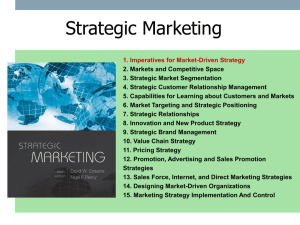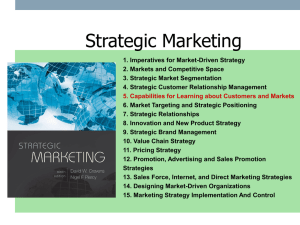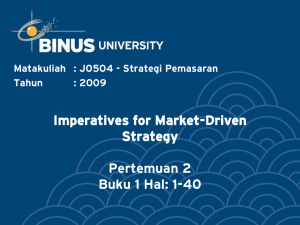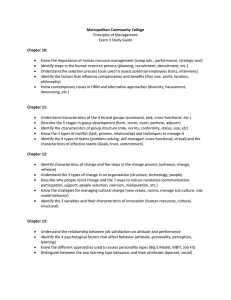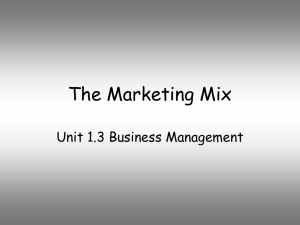Imperatives for Market-Driven Strategy Pertemuan 1 Buku 1 Hal: 1-40
advertisement
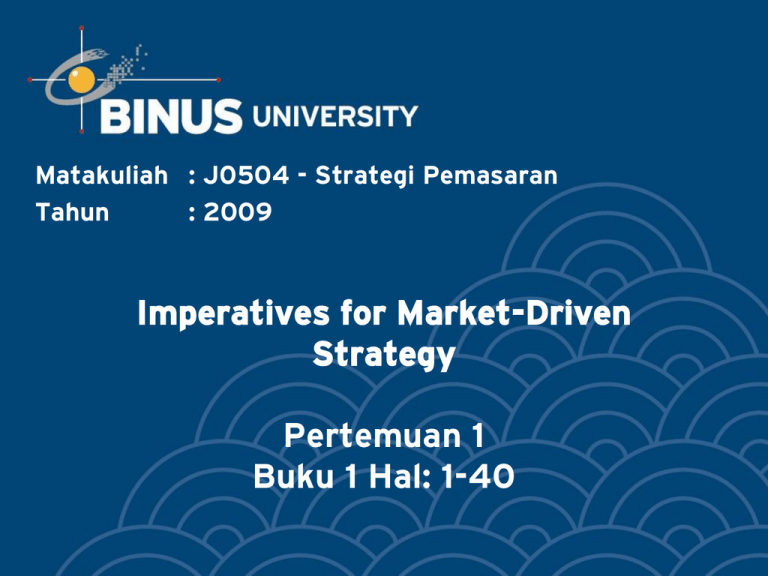
Matakuliah : J0504 - Strategi Pemasaran Tahun : 2009 Imperatives for Market-Driven Strategy Pertemuan 1 Buku 1 Hal: 1-40 Learning Objective • Pivotal role of market-driven strategy in designing and implementing business/marketing strategies • Links between business/marketing strategy and corporate strategy • Challenges in the modern environment Bina Nusantara Characteristics of a Market-Driven Strategy Becoming MarketOrientation Achieving Superior Performance Customer Value/ Capabilities Match Determining Distinctive Capabilities Market-Driven Strategy (1) • Becoming market-oriented – – – – Customer focus Competitor intelligence Cross-functional coordination Performance implications Characteristics of Market Orientation • Customer Focus What are the customer’s value requirements? Competitive Intelligence Importance of understanding the competition as well as the customer Cross-Functional Coordination Remove the walls between business functions Performance Consequences Market orientation leads to superior organizational performances Becoming a Market-Oriented Organization Information Acquisition Cross-Functional Analysis of Information Shared Diagnosis and Coordinated Action Delivery of Superior Customer Value Market-Driven Strategy (2) • Becoming market-oriented – – – – Customer focus Competitor intelligence Cross-functional coordination Performance implications • Determining distinctive capabilities DISTINCTIVE CAPABILITIES “Capabilities are complex bundles of skills and accumulated knowledge, exercised through organizational processes, that enable firms to coordinate activities and make use of their assets.” Capabilities Disproportiona te (higher) contribution to superior customer value Compelling Logic of Distinctive Capabilities Provides value to customers on a more cost-effective basis Capabilities Desirable Capabilities Applicable to Multiple Competition Situations Superior to the Competition Difficult to Duplicate Market-Driven Strategy (3) • Becoming market-oriented – – – – Customer focus Competitor intelligence Cross-functional coordination Performance implications • Determining distinctive capabilities • Types of capabilities EXTERNAL EMPHASIS Organization’s Process INTERNAL EMPHASIS Outside-In Processes Inside-Out Processes Spanning Processes Market sensing Customer linking Customer order fulfillment Channel bonding Technology monitoring Pricing Purchasing Customer service delivery New product/service development Strategy development Financial management Cost control Technology development Integrated logistics Manufacturing/ transformation processes Human resources management Environment health and safety Market-Driven Strategy (4) • Becoming market-oriented – – – – Customer focus Competitor intelligence Cross-functional coordination Performance implications • Determining distinctive capabilities • Types of capabilities • Creating value for customers Matching Customer Value and Distinctive Capabilities Value Requirements Distinctive Capabilities CREATING VALUE FOR CUSTOMERS Customer Value: Value for buyers consists of the benefits less the costs resulting from the purchase of products. Superior value: positive net benefits Creating Value: “Customer value is the outcome of a process that begins with a business strategy anchored in a deep understanding of customer needs.” Value Composition Product Services Employees Benefits Image Value (gain/loss) Monetary costs Time Psychic and physic costs Costs (sacrifices) Market-Driven Strategy (5) • Becoming market-driven – Marketing sensing capabilities – Customer linking capabilities – Aligning structure and processes Market Driven Initiatives Market Sensing Capabilities – Effective processes for learning about markets – Sensing: • Collected information needs to be shared across functions and interpreted to determine proper actions. Customer Linking Capabilities – Create and maintain close customer relationships Aligning Structure and Processes – Potential change of organizational design • Improve existing processes • Process redesign – Cross-functional coordination and involvement – Primary targets for reengineering: • Sales and marketing, customer relations, order fulfillment, and distribution

